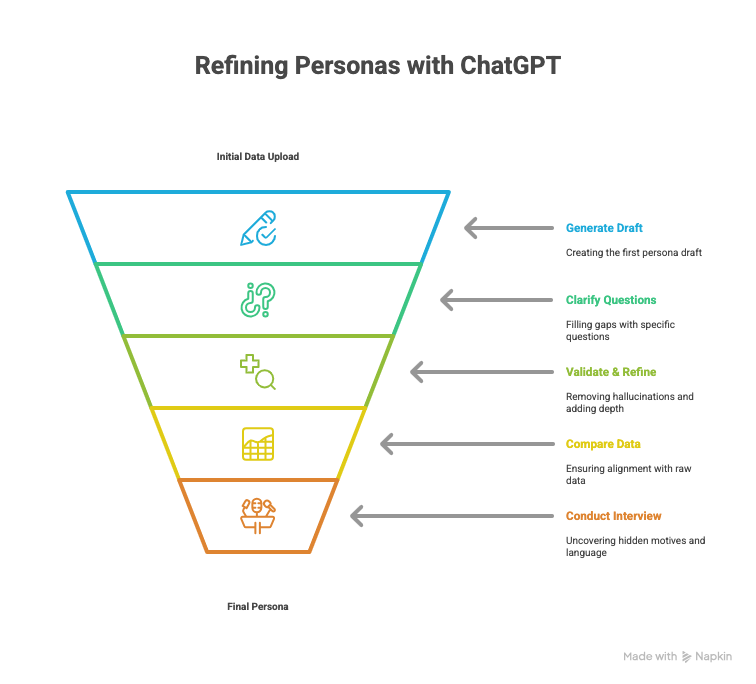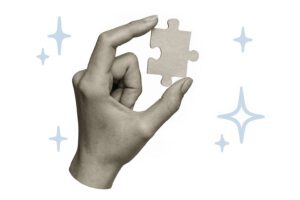📝 TL;DR
An ai customer persona is a semi-fictional profile built to mirror a real audience segment so you can serve the right message in overcrowded feeds.
Data First: Combine primary sources (platform insights, web analytics, interviews) with vetted secondary sources (industry reports, competitor reviews). Garbage in → garbage out.
5-Phase Workflow:
1) Kick-off prompt + data upload
2) answer clarifying questions
3) refine with micro-prompts
4) cross-check every claim against raw evidence
5) role-play an interview to surface hidden motives and language
What Is an AI Customer Persona?
In two seconds: an Ai Customer Persona is a semi-fictional profile that represents a real segment of your target audience.
Regardless of whether you refer to it as a buyer, audience or follower persona, the objective remains the same: to understand motivations, pain points, and behaviours so you can speak to the right audience with the right message at the right time.
Why Personas Matter Specifically for Social Media
You know the drill: content overload is real (yes, that rhymes).
In a feed where everyone tries to have a slice of the cake, targeting your exact audience is non-negotiable.
A clear, well researched persona helps you find out:
- What to post (relevant topics & formats)
- Who you’re talking to (demographics & psychographics)
- Which problems to solve (pain points)
- What tone to use (brand voice alignment)
- Where genuine interests lie (hobbies, values, community hot-spots)
Without it, you’re just adding noise.
Traditional Persona Building vs. AI-Assisted
| Time | Cost | Depth | Adaptability | |
| Classic workshops and surveys | Weeks-Months | High (researchers, focus groups) | Medium (sample-size limits) | Low (static PDF) |
| ChatGPT-assisted workflow | Hours-Days | Low-Medium (tooling) | High (unlimited Q&A) | High (iterate in real-time) |
However, please note, you should definitely view ChatGPT as a co-researcher and role-player, instead of an oracle. Feed it reliable data, and it can simulate your target audience via role-play (think: ChatGPT to mimicsa genuine conversations with your ideal audience).
But remember: garbage in → garbage out. The more time you invest in data-gathering and set-up, the more accurate (and beneficial) the outcome!
What Data to Use for Your Social Media Persona
| Primary Data (= data you collected) | Secondary Data (= third-party or public) |
| • Instagram/Facebook/TikTok/YouTube Insights | • Industry reports & whitepapers (important: check reliability!) |
| • Website analytics & CRM exports | • Competitor case studies |
| • Reviews on Google, Trustpilot, etc. (see tool below) | • Market-research databases |
| • Customer interviews & FAQ logs | • Social-listening tools |
| • Academic journals & trend reports |
💡 Pro Tip:
Whenever I don’t have much primary data available, I like to look at competitor reviews on platforms such as Google, Trustpilot and Amazon, as well as checking the comments on their social media posts. To save time, I use exportcomments.com (it’s free!) to download the comments as a CSV file instead of copying them manually. Then I analyse the sentiment and identify common pain points using ChatGPT.
How to create the AI Customer Persona with ChatGPT
Below, you’ll find the exact workflow that I use to build a data-based social media AI persona, inspired by the workflow from Content Creation mit KI by Andreas Berens and Carsten Bolk (2024) – which I highly recommend if you want a more in-depth look in the form of a physical hardcover book.
Each phase has a clear action and finish line, so you always know what to do next.

| Phase | Action | Goal |
| 1 | Kick-off prompt + upload data | Generate the first persona draft |
| 2 | Answer clarifying questions | Fill gaps without guessing |
| 3 | Validate & refine with micro-prompts | Remove hallucinations, add depth |
| 4 | Compare persona vs. raw data | Ensure it still matches reality |
| 5 | Persona interview (role-play) | Surface hidden motives & language |
(*ehem* Yes, it may seem overwhelming at first, but each stage improves accuracy and saves you from headaches later on. Trust me on this one.)
Phase 1: Kick-off Prompt (the only long one)
Before we start prompting, make sure to first summarise the data you’ve already collected (See section “What Data to Use for Your Social Media Persona” above). I definitely recommend organising everything into one or more files, with .docx or .csv usually working best. This is especially important when dealing with qualitative data, like comments or user pain points.
Try to structure this kind of information as clearly as possible: use bullet points, numbered lists or simple tables to keep things clean and digestible for ChatGPT.
A good rule of thumb I’ve learned (the hard way): more words don’t equal more insight. Keep it concise when you list pain points and avoid overexplaining. Just get straight to the point.
Here’s the exact prompt you can simply copy and paste in order to complete phase 1 (don’t forget to attach your files):
You are ChatGPT acting as a market researcher. Analyse the attached data and create a complete user persona.
## TASK
1. Condense the data into a credible persona and make no additional assumptions.
2. Use exactly these fields:
- Name (fictional)
- Age & life stage
- Profession/Role
- Goals & motivations
- Pain points/Challenges
- Deficiencies
- Typical quote (1 sentence derived from the data)
- Behavioral/Attitudinal traits
3. If information is missing, ask precise follow-up questions instead of guessing.
## RULES
- Rely strictly on the attached files.
- Do not fabricate facts or assumptions beyond the data.
What happens next? There are two possible outcomes:
ChatGPT returns a persona → congrats! You can skip straight to Phase 3.
ChatGPT asks clarifying questions → almost there! Continue with Phase 2.
Phase 2: Answer Clarifying Questions
ChatGPT noticed missing data and is politely asking for it. This is good; it means the model would rather fill gaps than invent facts.
How to respond:
- Keep replies short, factual and labelled (e.g., “€6.80 average spend, May 2025 POS export (P)”). To keep things tidy: whenever I have extra time I like to tag each reply with “(P)” or “(S)” so I remember what came from primary or secondary sources.
- Resist the urge to add strategy notes in order to avoid manipulating the dataset.
- When all questions are answered, end your message with “That’s all the data I have.” This signals the model to build the persona.
Phase 3: Validate & Refine with Micro-Prompts
Yay! You now have a draft persona, and it’s time for a thorough audit. Micro-prompts are definitely your friend here: by asking the model to make one small, precise change per prompt, you keep the chat history organised, minimise hallucinations, and retain the ability to roll back if something goes off the rails.
| Goal | Follow-Up Prompt | Goal |
| Trace every statement | “Mark each persona line with ‘[P]’ for primary data and ‘[S]’ for secondary.” | Instant credibility check. |
| Prioritise pains | “Rank the pain points from high to low impact and justify each in one sentence.” | A clear focus for your content roadmap. |
| Stress-test behaviour | “Simulate how this persona reacts to a 20 % price increase; answer in four sentences.” | Confidence that the persona behaves like a real customer, not a mannequin. |
💡 Pro Tip:
If you’re unsure whether a micro-prompt is clear, simply ask the tool itself (in our case ChatGPT) what their ideal prompt would look like:
“Act as a prompting expert and suggest improvements to this prompt: [paste here].”
Phase 4: Compare the Persona with Your Data
At this stage the ai customer persona looks convincing, but you haven’t proven it yet. Phase 4 is a reality-check loop where you hold every statement in the profile up against the raw evidence (= your data) you originally supplied. Think of it as peer review for marketing: if a claim can’t be traced back to data, it doesn’t graduate to the final persona.
Open your persona draft side-by-side with your raw data and:
- Highlight any claim you can’t trace to a data point.
- Remove buzzwords you’ve never heard customers say.
- Add missing information (e.g., seasonal spending spikes) that the model overlooked.
Phase 5: Persona Interview (Role-Play)
You superstar! You’ve wrestled the data monster, pruned the nonsense and now it’s show-time. For this I’ll illustrate the process with a fictional small-coffee-shop example. Imagine Bean & Beam, a cosy neighbourhood café that’s just getting serious about Instagram and TikTok and has created a social media persona called Sophie.
Starter prompt:
“From now on, speak only as the persona in first person. Stay consistent with the latest profile. If you don’t know something, say ‘I’m not sure.’ Acknowledge with ‘Ready.’”
When ChatGPT answers “Ready,” treat the chat like Sophie’s favourite barista and ask open W-questions: who, what, when, where, why, which, whose, how
I’ve learned about this approach in Content Creation mit KI by Andreas Berens and Carsten Bolk (2024) and I have found it to be incredibly helpful everytime I tried it myself.
| Ask Sophie… | Goal |
| “What makes you choose Bean & Beam over that big chain two doors down?” | Spots the value props to spotlight in Reels and Stories. |
| “When was the last time a coffee brand wowed you on Instagram, and what exactly grabbed you?” | Surfaces content formats and aesthetics that hook her. |
| “Who do you trust for coffee recommendations—friends, influencers, or review apps?” | Reveals partnership or micro-influencer opportunities. |
Keep asking questions until Sophie starts repeating herself or wandering off topic, because that’s usually your saturation point.
💡 Pro Tip (literally):
Using ChatGPT Pro? Use all of the Information you’ve gathered and gained throughout this process to create a CustomGPT.
How to Use Your AI Customer Persona to Create Better Social-Media Content
So you’ve finished the five-phase marathon, now comes the fun part: using all that insight to create social media content targeted at your audience. Here are some examples:
1. Map Pain Points → Content Pillars
Grab Sophie’s top pain points and narrow down your content pillars based on them:
| Pain Point | Content Pillar | Why It Works |
| “I skip breakfast because I’m always late.” | Quick-Fuel Hacks | Reels with 30-second breakfast ideas solve her problem on the spot. |
| “I’m on a tight budget.” | Smart-Spend Sips | Carousels on brewing café-quality coffee at home build trust and relatability. |
| “My feed is full of boring coffee pics.” | Caffeine Meme Therapy | Relatable memes and GIFs mirror her daily struggles (plus: built-in shareability). |
💡 Pro move (and if you’ve got EXTRA extra time):
For each pillar, add two sub-categories: Solve (educational) and Relate (entertaining). That balance keeps your grid useful and fun.
2. Research What’s Actually Trending
Search each pillar keyword on TikTok, Instagram Reels, or YouTube Shorts. Filter by “last 30 days” and note:
- Formats that exploded (looping shots? first-person view?)
- Captions and hooks that drove comments
- Sounds or music that keep re-appearing
Remember: skip anything older than a month as trends age faster than latte foam (bad joke, I’m sorry)
3. Ask your AI Customer Persona directly
Fire up your CustomGPT and say:
“Sophie, what kind of short-form coffee videos make you hit Save?”
Her answer gives you fresh angles, but remember: AI can hallucinate viral, generic content. Therefore, take it with a pinch of salt.
4. Validate Inside the Apps
Before you plan and storyboard, check if real posts match Sophie’s suggestions. If she raves about “dance-challenge latte art” and you can’t find a single well-performing example, trust the platform, not the bot.
Credibility Safeguards & Common Pitfalls
We both know you’re a busy bee, but let’s still make sure to keep your shiny ai customer persona (and your legal department) safe.
- Mind GDPR & Privacy
Strip names, emails, phone numbers. Replace “Lucy Smith” with “Customer #47.” Remember: ChatGPT is still a third-party processor. - Ban the Generic Persona
If your profile sounds like “Millennial Marketer” or “Gen-Z Foodie,” you’ve zoomed out too far and have to niche down. - Don’t Stop at Phase 1
A single prompt + data dump = an okay persona. The extra validation rounds = a great one. Invest the time because, let’s be honest, future-you will thank current-you. - Structure Data Clearly
Said it before and I’ll say it again: upload bullet-point lists, headers, numbered items. ChatGPT reads clean formats better than walls of text. - Refresh Regularly
Algorithms shift, seasons change and people discover matcha. Set a quarterly calendar reminder to rerun Phases 1-4 and check the fit.
Frequently asked questions
Social media personas help understand your target audience’s demographics, interests, and behaviors, enabling more relevant and engaging content. They guide tone, style, and platform choice to better resonate with followers and increase engagement.
They represent ideal audience segments, helping creators and businesses tailor content to specific needs, preferences and behaviors. This improves engagement, builds stronger connections and increases the effectiveness of marketing efforts.
Start by gathering solid data (platform insights, site analytics, interviews, competitor reviews). Spot recurring themes, draft a profile then stress-test it: trace every claim back to evidence, refine pain-point priorities, and revisit quarterly to keep it fresh
1. Kick-off prompt including well structured and detailed data to create your first draft.
2. Answer clarifying questions to fill in the data gaps.
3. Micro-prompts to sharpen details.
4. Compare claims to raw data to remove guesswork.
5. Role-play an interview to uncover language and hidden motives.
Remember: good data in, great persona out.


